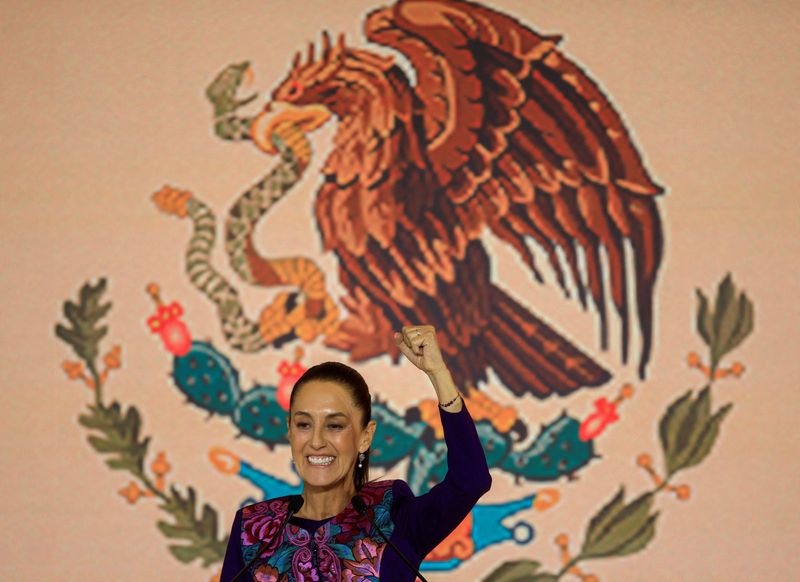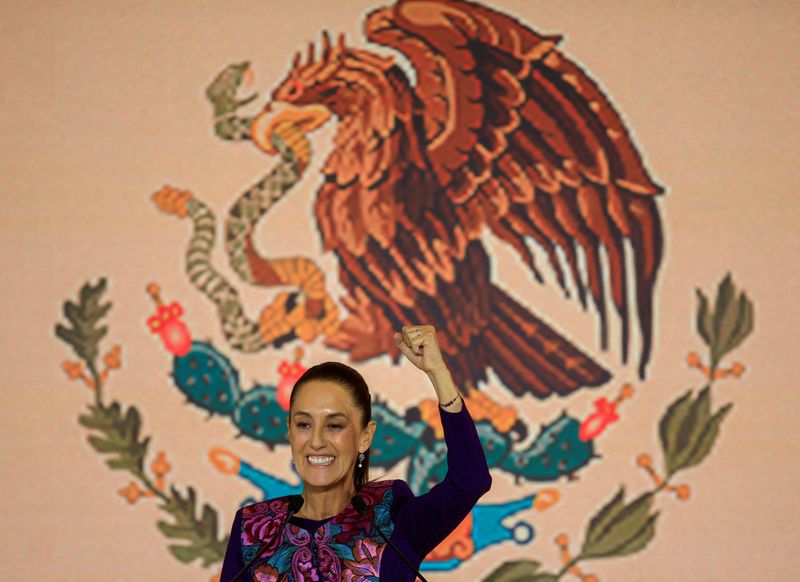Commodities
Analysis-Can Mexico’s Sheinbaum, a climate scientist, shake Lopez Obrador’s oil legacy?

By Cassandra Garrison
MEXICO CITY (Reuters) – Mexico’s President-elect Claudia Sheinbaum, an accomplished climate scientist, could struggle to fulfill her environmental pledges after she sailed to victory, in part, on the popularity of a predecessor who doubled down on fossil fuels.
Sheinbaum, elected as Mexico’s first woman president by a sweeping margin Sunday, inherits a country grappling daily with climate change and environmental challenges: pervasive drought, a water crisis in the sprawling capital of Mexico City, and rampant deforestation.
The 61-year-old leftist leader, who was part of a United Nations panel of climate scientists that received a Nobel Peace Prize in 2007, has spoken about her belief in an academic and scientific approach to politics. She campaigned on a pledge to significantly boost renewable energy in the oil-producing country to as much as 50% by the end of her term in 2030.
But despite her best intentions to improve Mexico’s green record, Sheinbaum’s mentor, the highly popular outgoing President Andres Manuel Lopez Obrador, spent billions propping up Mexico’s fossil fuel-dependent state energy giants, oil firm Pemex and power utility CFE.
Her overwhelming victory – and the possible congressional super majority won by the ruling coalition – is in many ways a referendum on Lopez Obrador’s policies and initiatives, said Mariana Campero, senior associate with the CSIS Americas Program.
Sheinbaum could be hard-pressed to break cadence with Lopez Obrador’s style at the risk of losing support, limiting her ability to prioritize climate change policies.
“She has said repeatedly that she will continue with his policies and that her government will be a continuation of his government,” said Campero. “But she has always said that green energy is important.. So how will she square that circle?”
GREEN AT HEART?
Sheinbaum has credited her upbringing by a chemical engineer father and cellular biologist mother for fostering her interest in science and politics. She has a doctorate in energy engineering from the National Autonomous University of Mexico.
As mayor of Mexico City, she installed a roof-top solar project at a busy central market and inaugurated a 100% electric bus line.
But she faced criticism for some projects, including the construction of a bridge in the Xochimilco ecological zone that community members said damaged wetlands. She also supports some of Lopez Obrador’s most controversial projects, including the Mayan Train, a tourist railway that activists and scientists decry for endangering pristine wilderness and ancient cave systems beneath the jungle floor.
Still, her rise to the presidency has fueled hope among some that she could turn things around for the country’s track record on climate change policies, which deteriorated under Lopez Obrador, according to the Climate Change Performance Index, largely due to increased subsidies for fossil fuels and poor progress in curbing deforestation.
“I definitely think that she has that will and intention to put Mexico back on net-zero targets and in the good graces of the international community,” Arthur Deakin, director of energy at consultancy America’s Market Intelligence.
THE PEMEX PROBLEM
Sheinbaum has pledged to boost wind and solar energy as part of a $13.57 billion investment in new energy generation projects. She is, however, also facing the biggest budget deficit in decades, left behind by Lopez Obrador, a reality that will force her to pick and choose how to dedicate spending.
Despite being the world’s most indebted energy company, Pemex is still a major contributor to state coffers, said Alejandra Lopez, a public policy consultant who specializes in energy issues.
The firm is a heavy emitter of greenhouse gases, but it is also an important national symbol of energy sovereignty for many Mexicans, including Lopez Obrador.
Pemex stirs a sense of “emotional, historical and sentimental” importance within the country, Lopez said.
Sheinbaum is a vocal believer in the role of the state in Mexico’s energy sector, long dominated by Pemex, which could make it tough to keep her promise to increase renewable energy.
A business-savvy approach could enable her to attract investment and spur realistic change towards decarbonizing the energy and transportation sectors, Deakin said.
Sheinbaum could start by increasing the limit for Distributed Generation (DG) projects, typically small privately-funded solar or wind farms that are built to supply energy to a specific factory or industrial site.

Upping the cap from the current 0.5 megawatts to 5 megawatts, like Brazil has done, could increase clean electricity for commercial industrial users, Deakin said. She could introduce biofuel policies and increase electric vehicle (EV) subsidies and charging infrastructure. A national carbon credit framework could help accelerate interest in low carbon initiatives.
“It’s a little harder when you’re struggling with a more constrained budget, but there’s other ways that emerging markets are able to create a more attractive environment for renewable electricity,” Deakin said.
Commodities
Oil prices rise; U.S. crude inventories plunge, Russia-Ukraine truce eyed
Commodities
India’s Reliance to stop buying Venezuelan oil over US tariffs, sources say
Commodities
Oil prices climb on Venezuela supply worries

 Forex3 years ago
Forex3 years agoForex Today: the dollar is gaining strength amid gloomy sentiment at the start of the Fed’s week

 Forex3 years ago
Forex3 years agoUnbiased review of Pocket Option broker

 Forex3 years ago
Forex3 years agoDollar to pound sterling exchange rate today: Pound plummeted to its lowest since 1985

 Forex3 years ago
Forex3 years agoHow is the Australian dollar doing today?

 Cryptocurrency3 years ago
Cryptocurrency3 years agoWhat happened in the crypto market – current events today

 World3 years ago
World3 years agoWhy are modern video games an art form?

 Commodities3 years ago
Commodities3 years agoCopper continues to fall in price on expectations of lower demand in China

 Economy3 years ago
Economy3 years agoCrude oil tankers double in price due to EU anti-Russian sanctions























